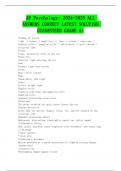AP Psychology: 2024-2025 ALL
ANSWERS CORRECT LATEST SOLUTION
GUARANTEED GRADE A+
Pathway of Vision
light -> cornea -> pupil/iris -> lens -> retina -> rods/cons ->
bipolar cells -> ganglion cells -> optic nerve -> optic chiasm ->
occipital lobe
Cornea
Clear, protective cover on the eye
Pupil/iris
Controls light entering the eye
Lens
Focuses light onto retina
Fovea
Best vision (cones)
Rods
black/white, dim light
Cones
Colors, bright light
Bipolar cells
Connects rods/cones and ganglion cells
Ganglion cells
opponent-processing occurs here
Blind spot
The point at which the optic nerve leaves the eye
Feature detectors
Cells that see motion, shapes, lines, etc. and are located in the
occipital lobe
Opponent processing theory
Red/green, blue/yellow, black/white cancel out (after image)
Trichromatic theory
Red, green, and blue cones (explains color blindness- the cones type
is missing)
Visual capture
Vision wins
Stroboscopic movement
Motion produced by a rapid succession of slightly varying images
(animations)
Interposition
Overlapping images appear closer
,Relative size
Object farther away is smaller
Relative clarity
Blurry objects are farther away
Texture gradient
More textured objects are closer
Relative height
Object higher up on the page (closer to horizon) and farther away
Linear Perspective
The longer the lines, the closer they are
Retinal disparity
image is cast slightly different on each retinal, location of image
helps us determine depth
Convergence
Eyes cross when an object gets closer
Top down processing
Previous knowledge (whole) -> smaller parts
Example: if the letters in a word are mix-matched, as long as the
first and last letter are in the same spot, the word can be read
correctly
Bottom up processing
sensory info from stimulus -> whole
Example: When you read, you read each letter to make a full word.
Auditory pathway
Sound -> pinna -> auditory canal -> tympanic membrane (ear drum) ->
ossicles (hammer, anvil, stirrup) -> oval window -> cochlea ->
auditory nerve -> temporal lobe
Outer ear
Pinna and auditory canal
Middle ear
Tympanic membrane, ossicles
Inner ear
Cochlea (processes sound first)
Place theory
location where hair cells bends determines sound (high pitches)
Frequency theory
rate at which action potentials are sent determines sound (low
pitches)
Conduction deafness
Ossicles break (middle ear) and cannot be fixed
Nerve deafness
listening to music too loud, old age, hereditary (inner ear problems)
and can be improved
Pain gate control theory
,Spinal cord gate closed = no pain
kinesthetic sense
Body position and movement (are you walking in a straight line or
bumping into walls?)
Vestibular sense
Balance (semicircular canals in the inner ear effect this)
Gustation
Bitter, salty, sweet, sour, umami (savory)
Olfaction
Only sense that does not go through the thalamus (goes through
temporal lobe and amygdala)
Gestalt Psychology
Whole picture
Figure ground
Objects (figures) are distinct from surroundings (ground)
Closure
Close the gaps
Proximity
Groups
Similarity
Patterns
Continuity
Flow
Conscious
Controlled processes and totally aware
Preconscious
Outside awareness but accessible
Example: remembering your first grade teacher's name when you are in
12th grade
Subconscious
Automatic processing
Example: heart rate
Unconscious
Not within thought; not awake
Altered states
Produced through tiredness, drugs, or hypnosis
Beta waves
Awake and alert (you beta be awake for the AP exam)
Alpha waves
Drowsy
Stage 1 of sleep
Light sleep (alpha and theta waves)
Stage 2 of sleep
, Deeper sleep but not deepest (theta waves interrupted by bursts of
sleep spindles)
Stage 3 of sleep
Deepest sleep (delta waves)
REM sleep
Dreaming with beta waves (rapid eye movement, heart rate increases,
breathing increases)
Sleep cycle
90 minutes long (1 - 2 - 3 - 2 - 1- REM), REM lasts the longest
Circadian rhythm
24 hour biological clock controlled by SCN (body temp and sleep, and
explains jet lag)
Insomnia
Difficulty in falling asleep or staying asleep due to stress or
anxiety
Sonambulism
Sleep walking (stage 3) due to fatigue, drugs, or alcohol
Night terrors
Extreme nightmares that wake a child up with bloodcurdling screams
(not in REM)
Narcolepsy
Fall asleep out of nowhere (due to a deficiency in orexin)
Sleep Apnea
Stop breathing suddenly while asleep (due to obese usually)
Freud's unconscious wish fulfillment
Dreaming is gratification of unconscious desires and needs
Latent content
Deeper meaning of dreams
Manifest content
Surface level meaning of dreams
Activation synthesis
Brain produces random bursts of energy
Benefits of hypnosis
Reduce pain and help relax
Depressants
Decrease sympathetic NS and highly addictive (alcohol, barbiturates,
tranquilizers, narcotics)
Stimulants
Increase sympathetic NS and highly addictive (amphetamines, cocaine,
MDMA, caffeine, nicotine)
Hallucinogens
Causes hallucinations but not extremely addictive (LSD, marijuana)
Tolerance
Needing more of a drug to achieve the same effects




